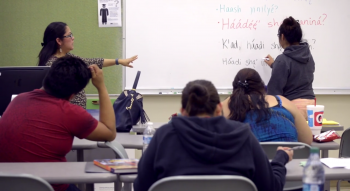Is Navajo Difficult To Learn
April 17, 2014
Navajo is not only a language that may be learned through classes at Arizona State University, information technology's a way for students to reconnect to their culture.
"Language is ane key thing. Yous can still be Navajo without knowing the language simply there are a lot of teachings, like songs and ceremonies, that can't be sung in English. It wouldn't make sense and it wouldn't be the same," said Elijah Allan, an ASU senior majoring in conservation biological science and geology with a small in American Indian Studies.  Download Full Image
Download Full Image
Teaching classes in Navajo is likewise helping to revitalize what is at present classified as a dying language, said Jolyana Begay, an American Indian Studies teacher who teaches beginner and intermediate Navajo classes.
"I actually feel that it is my duty, my role as a speaker of the language, to ensure its being and teach to our future generations. It makes me happy that students take a very strong interest in the language," Begay said.
Freshman Cora Tso decided to abound closer to her culture by taking Navajo classes. She would similar to see more Navajo youth embrace their language and acquire how it relates to the traditional way of life. Tso, who grew upward in Page, came to the realization of what information technology meant to master the linguistic communication afterward learning nigh the history of the Navajo people and what her ancestors and grandparents have experienced.
"Immature people don't realize that their culture and their language are dying. I learned near the importance of clans, traditions and customs growing upwards. I knew it was important," Tso said. "I feel it'due south a personal duty to myself and to my time to come children to keep the linguistic communication going so they tin can know the importance of what it is to be Navajo."
Learning the language that belongs to them
Classroom sessions focus on reading, writing and speaking the indigenous linguistic communication. Interspersed among the lessons are discussions about the culture, focusing on topics such as the importance of clans and what livestock means to the Navajo people.
"We're fortunate to provide opportunities that allow students to learn the linguistic communication that belongs to them," said Begay, whose clans are Red Running into the Water People, Black Streak Wood People, Cerise Bottom Cheek People and Giant People of the Red Running in the Water People. "Navajo is a very descriptive language that is verb-based. It sounds a lot like poetry."
Allan realized he wanted to learn more than about his language and his civilization while he was enlisted in the U.S. Army, and fellow soldiers would ask about his heritage. At times, he didn't take an answer. He also worked with the Navajo Nation Emergency Medical Services, where knowing the language can help in treating those whose only language is Navajo.
That led him to the realization that he had missed out on cultural aspects of his tribe when he was growing upward on the Navajo Reservation. Allan's mother was fluent in Navajo, but didn't teach it to her children, mayhap because of what she experienced during boarding schoolhouse, said Allan, who went to school in Tuba Urban center and Kayenta, and is from Shonto and Toligai on the Navajo Nation. His clans are Salt Association, Caucasian People and Bitterwater.
"They were physically abused and punished for talking the language," Allan said. "Language is a big part of our society and culture, and information technology makes your community stronger. It shows that people take pride in who they are."
Difficult linguistic communication, yet a reminder of home
Classes are structured in a manner that allows students to interact as much as possible in a language that is not easy to master.
"The Navajo language is a very difficult language to learn. Students need to learn to utilize muscles that are not used in English. The best way to learn is to try to speak," Begay said. "The Navajo language has diacritical markings, such as high tones, nasal sounds and glottalized consonants. It takes do."
Lab time spent exterior of class consists of interacting in Navajo through conversations with elders, speaking during ceremonies at home or talking with fluent speakers on campus.
"Information technology's difficult to teach my natural language to say the different vowel sounds and symbols," said Tso, whose clans are Reed People, Black-Streaked Woods, Bitterwater and Red House. "You lot demand to interact with others to know that you are saying it right."
Navajo class also gives many students a welcome reminder of home.
"Many of the students sometimes begin to feel homesick after moving from the reservation to ASU. They miss their grandmothers. They miss the audio of the linguistic communication," Begay said.
Allan, a Barrett Honors College pupil, hopes to utilise his language skills in his career, as he plans to work with Native people and be a vocalism for them, especially when it comes to teachings virtually the environment and people's relationship with the land.
Tso plans to help her people as she works toward a dual caste in American Indian Studies and political science. A Barrett Honors College student and Gates Millennial scholar, she plans to attend constabulary school and learn Indian law, eventually working for the tribe.
"I don't see many people talking about language preservation or cultural restoration. More students are working in the nowadays. I think we're all trying to do our best to piece of work with the earth nosotros've been born into," Tso said.
Is Navajo Difficult To Learn,
Source: https://news.asu.edu/content/learning-navajo-language-helps-students-connect-their-culture
Posted by: reedythrome.blogspot.com


0 Response to "Is Navajo Difficult To Learn"
Post a Comment